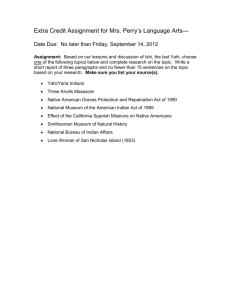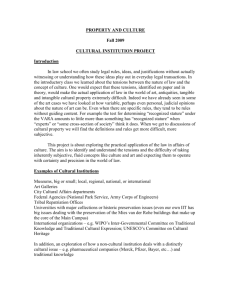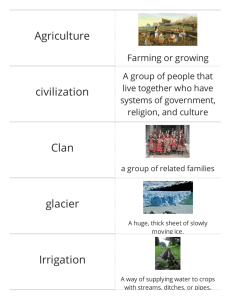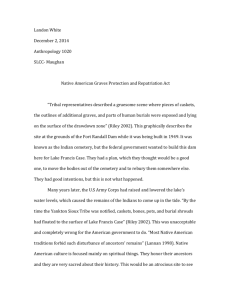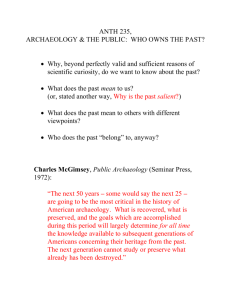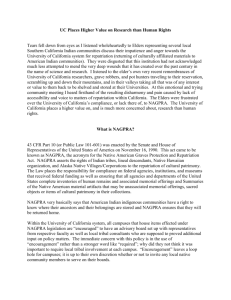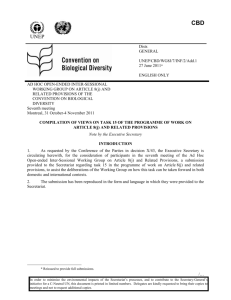v3n2_airorf f_w'96-97 - American Indian Ritual Object Repatriation
advertisement
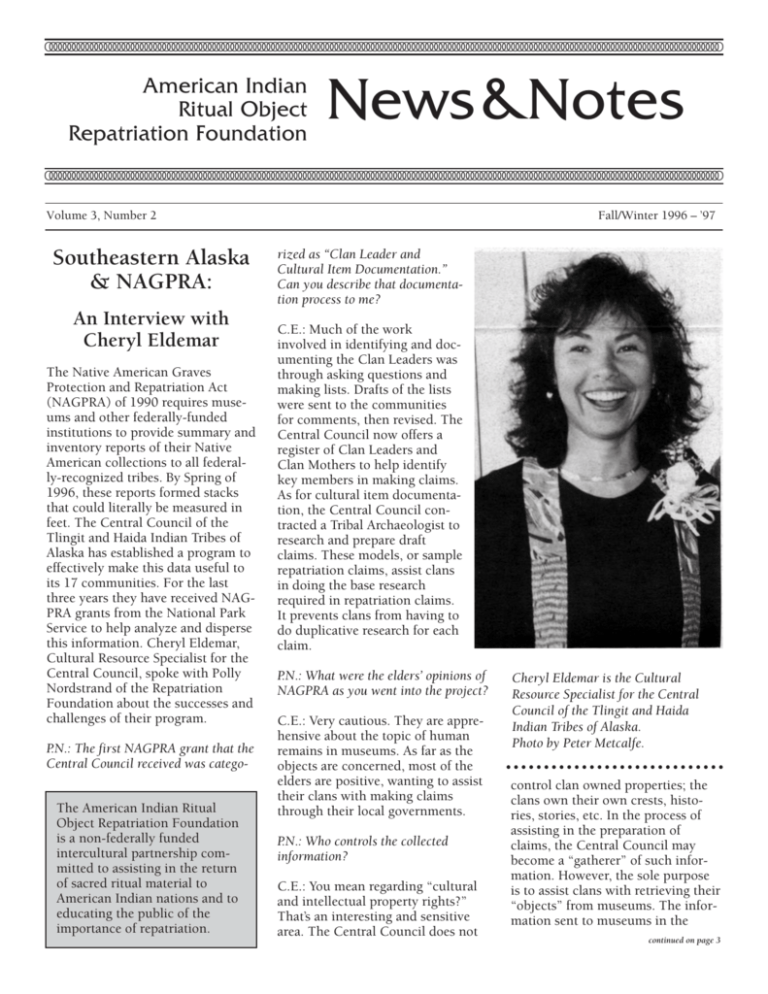
OOOOOOOOOOOOOOOOOOOOOOOOOOOOOOOOOOOOOOOOOOOOOOOOOOOOOOOOOOOOOOOOOOOOOOOOOOOOOOOOOOOOOOOOOOOOOOOOOOOOOOOOOOOOOOOOOOOOOOOOOOOOOOOOOOOOOOOOOOOOOOOOOOOOO American Indian Ritual Object Repatriation Foundation News&Notes OOOOOOOOOOOOOOOOOOOOOOOOOOOOOOOOOOOOOOOOOOOOOOOOOOOOOOOOOOOOOOOOOOOOOOOOOOOOOOOOOOOOOOOOOOOOOOOOOOOOOOOOOOOOOOOOOOOOOOOOOOOOOOOOOOOOOOOOOOOOOOOOOOOOO Volume 3, Number 2 Southeastern Alaska & NAGPRA: An Interview with Cheryl Eldemar The Native American Graves Protection and Repatriation Act (NAGPRA) of 1990 requires museums and other federally-funded institutions to provide summary and inventory reports of their Native American collections to all federally-recognized tribes. By Spring of 1996, these reports formed stacks that could literally be measured in feet. The Central Council of the Tlingit and Haida Indian Tribes of Alaska has established a program to effectively make this data useful to its 17 communities. For the last three years they have received NAGPRA grants from the National Park Service to help analyze and disperse this information. Cheryl Eldemar, Cultural Resource Specialist for the Central Council, spoke with Polly Nordstrand of the Repatriation Foundation about the successes and challenges of their program. P.N.: The first NAGPRA grant that the Central Council received was categoThe American Indian Ritual Object Repatriation Foundation is a non-federally funded intercultural partnership committed to assisting in the return of sacred ritual material to American Indian nations and to educating the public of the importance of repatriation. Fall/Winter 1996 – ’97 rized as “Clan Leader and Cultural Item Documentation.” Can you describe that documentation process to me? C.E.: Much of the work involved in identifying and documenting the Clan Leaders was through asking questions and making lists. Drafts of the lists were sent to the communities for comments, then revised. The Central Council now offers a register of Clan Leaders and Clan Mothers to help identify key members in making claims. As for cultural item documentation, the Central Council contracted a Tribal Archaeologist to research and prepare draft claims. These models, or sample repatriation claims, assist clans in doing the base research required in repatriation claims. It prevents clans from having to do duplicative research for each claim. P.N.: What were the elders’ opinions of NAGPRA as you went into the project? C.E.: Very cautious. They are apprehensive about the topic of human remains in museums. As far as the objects are concerned, most of the elders are positive, wanting to assist their clans with making claims through their local governments. P.N.: Who controls the collected information? C.E.: You mean regarding “cultural and intellectual property rights?” That’s an interesting and sensitive area. The Central Council does not Cheryl Eldemar is the Cultural Resource Specialist for the Central Council of the Tlingit and Haida Indian Tribes of Alaska. Photo by Peter Metcalfe. control clan owned properties; the clans own their own crests, histories, stories, etc. In the process of assisting in the preparation of claims, the Central Council may become a “gatherer” of such information. However, the sole purpose is to assist clans with retrieving their “objects” from museums. The information sent to museums in the continued on page 3 OOOOOOOOOOOOOOOOOOOOOOOOOOOOOOOOOOOOOOOOOOOOOOOOOOOOOOOOOOOOOOOOOOOOOOOOOOOOOOOOOOOOOOOOOOOOOOOOOOOOOOOOOOOOOOOOOOOOOOOOOOOOOOOOOOOOOOOOOOOOOOOOOOOOOO WELCOME! Why Repatriate Musical Instruments? F or 500 years in the Western Hemisphere, Indigenous peoples have waged a relentless battle for survival as distinct cultures. The right to remain Indigenous in the Americas has been continuously threatened by missionaries intent on “civilizing the Indian.” To this purpose, non-Native governments have enacted various prohibitions against Native music, dance, ceremonies, and the possession of paraphernalia related to such activities. Confiscated ritual objects usually found their way into private collections, museums, or universities. Regarded as exotic artifacts, curiosities, or remnants of “dead or dying” cultures, the original purposes and meanings of these objects were often unknown or misunderstood. Sacred objects, long employed by Native medicine people for spiritual and healing ceremonies, became objects of intellectual speculation and public amusement. Sacred medicine drums, flutes, rattles and other musical ritual objects are prepared in a manner which imbues them with specific powers and purposes. Each object wears the colors, symbols and other details of the dynamic vision or dream out of which it was born. These visions are recognized as spiritual manifestations that require expression in sacred forms. And every such creation is regarded as a living being, containing not only the unique vitality of the object itself, but the life forces of each material — mineral, plant and animal — out of which it is made. Today, collectors and connoisseurs appreciate the aesthetic and monetary value of these instruments. However, “caveat emptor”; these objects are alive, and remain alive until ceremonially put to rest. They can pose a great risk to the uninitiated. It is with this understanding that Native people are requesting the repatriation of musical instruments. Return to the ceremonial cycle and the proper fulfillment of purpose is essential to traditional Native reality, in order to maintain and promote the well-being of all life. Franc Menusan Board of Trustees, AIRORF Nez Perce Bring Historic Collection Home A unique 150-year-old collection of twenty Nez Perce historic artifacts, including clothing, jewelry and a cradleboard, was purchased from the Ohio Historical Society (OHS) by the Nez Perce of Idaho. Since 1981, the collection had been on loan from the OHS to the Nez Perce National Historical Park where it was displayed. The loan was terminated by the OHS in 1995. The Nez Perce community considered the items significant for understanding their history and teaching their culture, so they began a campaign to purchase the collection, which did not meet the criteria for repatriation under NAGPRA. Gaining local and national attention, the Tribe raised the necessary $608,100 with the assistance of dozens of Idaho schools, individuals, Native musicians, rock stars, and major corporations. Nez Perce Tribal Chairman Samuel N. Penney said of the purchase, “This historic event should not be seen as an acquisition of museum artifacts. It is a restoration of an important part of the Nez Perce culture...we have seen a light of respect and compassion which suggests a greater future for our United States.” RETROSPECT / UPCOMING ✺ Polly Nordstrand, Education and Repatriation Coordinator, represented AIRORF at the 91st annual meeting of the American Association of Museums in Minneapolis, May 4-8, 1996. ✺ AIRORF sponsored a Repatriation Workshop at the annual meeting of the National Congress of American Indians on June 2nd in Tulsa, OK. Representatives from 25 tribes attended the day-long workshop. Panelists included representatives from the National Museum of Natural History and the National Park Service, as well as contributing authors to Mending the Circle. ✺ The World Sacred Pipe Ceremony for Peace was conducted by Arvol Lookinghorse, Keeper of the Sacred Buffalo Calf Pipe, at the United Nations in New York on August 9th. The ceremony, attended by Polly Nordstrand, was part of the International Day of the World’s Indigenous People. OOOOOOOOOOOOOOOOOOOOOOOOOOOOOOOOOOOOOOOOOOOOOOOOOOOOOOOOOOOOOOOOOOOOOOOOOOOOOOOOOOOOOOOOOOOOOOOOOOOOOOOOOOOOOOOOOOOOOOOOOOOOOOOOOOOOOOOOOOOOOOOOOOOOOO OOOOOOOOOOOOOOOOOOOOOOOOOOOOOOOOOOOOOOOOOOOOOOOOOOOOOOOOOOOOOOOOOOOOOOOOOOOOOOOOOOOOOOOOOOOOOOOOOOOOOOOOOOOOOOOOOOOOOOOOOOOOOOOOOOOOOOOOOOOOOOOOOOOOOO continued from page 1 Perspectives repatriation claims includes a disclaimer stating that it is not to be reprinted or used for outside purposes. C.E.: We keep it very simple. It is a one page sheet with basic information about the claim: the date it was filed, the claimant (which clan or individual), the item being requested for repatriation, and the museum. Most of the objects are coming back to the group structure — the clan. The purpose of the Register is to inform communities at the beginning of the process about claims that are being made. We hope to avoid contesting claims after a lot of research and work has been done. It seems to work fairly well. P.N.: What other means are used to keep the community informed about repatriation? T oday, there is a practice of buying, selling, and re-creating ritual objects for use in the non-Indian world. These common practices raise the question: Does any artist have the right to use sacred images as subject matter within their artwork? The Indian community is divided on this issue. Many see it as a form of censorship where others believe they are protecting their religion. Many tribal people use the word traditional as a way of trying to enforce their opinion on others, but I have yet to see someone who can explain the word traditional and how it relates to the Indian world. Throughout our history, the Pueblo people have always worked toward progress. With the intervention of the non-Indian, things changed for us dramatically, and we survived by accepting the bad with the good. The use of our religious objects has affected the balance in our lives we so dearly respect. As long as an object is being sold on the open market as art, there should be no expectation that the image represented in that object is somehow protected. The only way to maintain the sanctity of any religious object or cultural artifact is not to reproduce it for sale to the general public. The individual tribal member, whether he or she is an artist or not, has a responsibility to the community to honor the religious practices of one’s tribe. If one is raised in the community with a strong orientation in the religion practiced by the tribe, that person knows when he or she crosses the line. Finally, the general public has a responsibility to understand that there is no stopping the practice of Indian religion throughout Indian country. When the tribes ask the mainstream community for support to be able to practice their religion and protect the use of ritual objects, this must be respected as anyone would respect his or her own religion. (Reprinted from Indian Artist with the author’s permission) [The statements and opinions expressed in the Perspectives column are not necessarily those of the Repatriation Foundation.] M ENDING THE C IRCLE: A NATIVE A MERICAN REPATRIATION G UIDE w le No ilab a Av C.E.: The Southeastern Alaska Regional Corporation (SEAlaska Corporation) publishes a quarterly newsletter, so if it is timely we can notify people about repatriation claims that way. The Central Council has also developed a NAGPRA database with 15,000 objects to date, input from the museum reports. Computer-linked communities have direct access to the database. To find objects from their area they can make regional searches — museums may have information about where the object came from. On a monthly basis we send out an update. We also offer workshops as a platform for museum and government experts to address the clans and communities directly. by Paul D. Gonzales, San Ildefonso Pueblo Av N o ail w ab le P.N.: The Central Council sends out a publication, Tribal Register, to community members about pending claims. What type of information does it provide? Borrowing Cultural Images If you would like to order a copy of Mending the Circle, please complete the form below and mail it with your check made payable to AIRORF in the amount of $31.00 (includes S&H). Name _________________________________________________________ Address ________________________________________________________ City/State/Zip ___________________________________________________ Telephone (____)__________________ _____(#) @ $31.00 ea. $11.00 is tax deductible as allowable by law. AIRORF, 463 East 57th Street, New York, NY 10022 OOOOOOOOOOOOOOOOOOOOOOOOOOOOOOOOOOOOOOOOOOOOOOOOOOOOOOOOOOOOOOOOOOOOOOOOOOOOOOOOOOOOOOOOOOOOOOOOOOOOOOOOOOOOOOOOOOOOOOOOOOOOOOOOOOOOOOOOOOOOOOOOOOOOOO OOOOOOOOOOOOOOOOOOOOOOOOOOOOOOOOOOOOOOOOOOOOOOOOOOOOOOOOOOOOOOOOOOOOOOOOOOOOOOOOOOOOOOOOOOOOOOOOOOOOOOOOOOOOOOOOOOOOOOOOOOOOOOOOOOOOOOOOOOOOOOOOOOOOOO Mending the Circle Update As of September, the Repatriation Foundation had distributed more than 450 complimentary copies of Mending the Circle: A Native American Repatriation Guide to Native nations, and had sold over 300 copies to interested individuals and institutions. [Please see page 3 for Order Form.] Repatriation Foundation Now on the World Wide Web You can now visit the American Indian Ritual Object Repatriation Foundation on the Web at http://www.repatriationfoundation.org Information about repatriation, the Foundation, and direct links to other relevant sites on the Web are all available. Our new site features News & Notes, a direct e-mail link, and information about the repatriation process. With just a click, you can access the National Archeological Database with the Native American Graves Protection and Repatriation Act (NAGPRA) and related documents. American Indian Ritual Object Repatriation Foundation 463 East 57th Street New York, NY 10022-3003 ADDRESS CORRECTION REQUESTED In Print Introductions Killing the White Man’s Indian: Reinventing Native Americans at the End of the Twentieth Century. Fergus M. Bordewich. New York: Doubleday, 1996. Explores contemporary Indian Country, and overturns the fallacies and myths surrounding Native Americans in the 1990’s. Board of Trustees: Walter EchoHawk, Esq., Pawnee; Michael Haney, Seminole/Sioux; Carol Master, M.D., Dr.P.H.; Franc Menusan, Creek/Metis; Elizabeth Sackler; Sheri Sandler, M.A.; Martin Sullivan, Ph.D.; Marilyn Youngbird, Arikara/Hidatsa. Founding Trustee: Reuben Snake, Jr., Winnebago (1937-1993). National Support Committee: Rabbi Marc Angel; Herb Beenhouwer; Jennifer Easton; Barbara Ettinger; D'Anne Hamilton, Inupiat; Faith Hubley; Marion Hunt-Badiner; Ranko Iwamoto; Oren Lyons, Onondaga; Ann R. Roberts; Stephanie Smith; and Lucinda Ziesing. Staff & Officers: Polly Nordstrand; Rebecca Hill; Jack Trope, Esq. and Neal I. Gantcher, Esq. (Counsel); Gina Genther; and Kelleigh Smith. Sweet Medicine: Sites of Indian Massacres, Battlefields, and Treaties. Photos by Drex Brooks, Essay by Patricia Nelson Limerick. Albuquerque: University of New Mexico Press, 1995. Presents recent photographs of important historic sites, many of which have been transformed into recreational areas or urban spaces. Native American Art and the New York Avant-garde: A History of Cultural Primitivism. W. Jackson Rushing. Austin: University of Texas Press, 1995. Examines the incorporation of Native American iconography by American modernist artists such as Marsden Hartley, John Marin, and Jackson Pollock. News & Notes is published bi-annually by the American Indian Ritual Object Repatriation Foundation, 463 East 57th Street, New York, NY 10022. We encourage the reproduction of articles from News & Notes. Please credit the American Indian Ritual Object Repatriation Foundation & the author of the article. News & Notes is a collaborative effort of Elizabeth Sackler, Polly Nordstrand, Kelleigh Smith, & Marilyn Ewer of MKE Enterprises. Printed on recycled paper. NONPROFIT ORG. U.S. POSTAGE PAID NEW YORK, NY PERMIT NO. 7178
